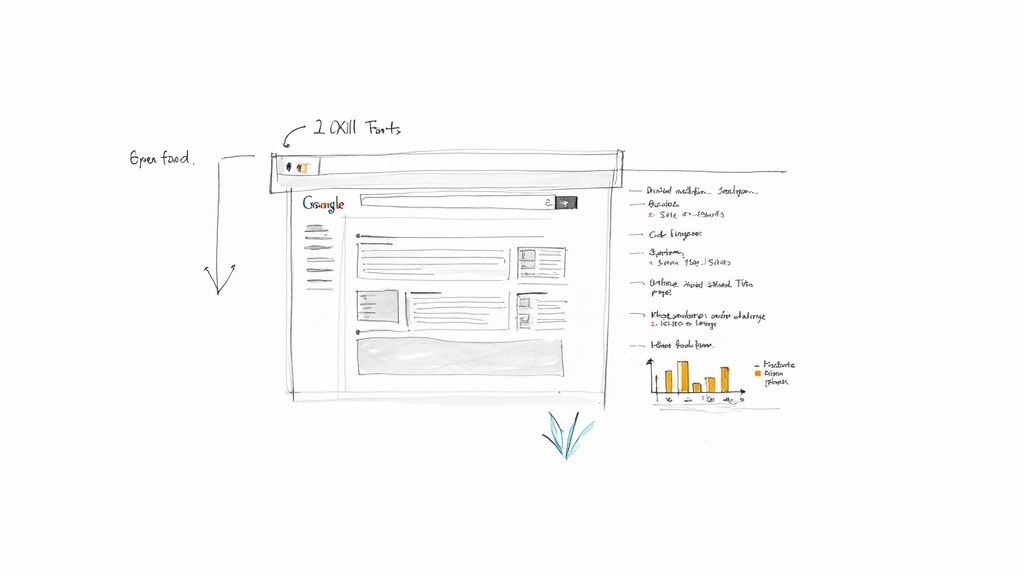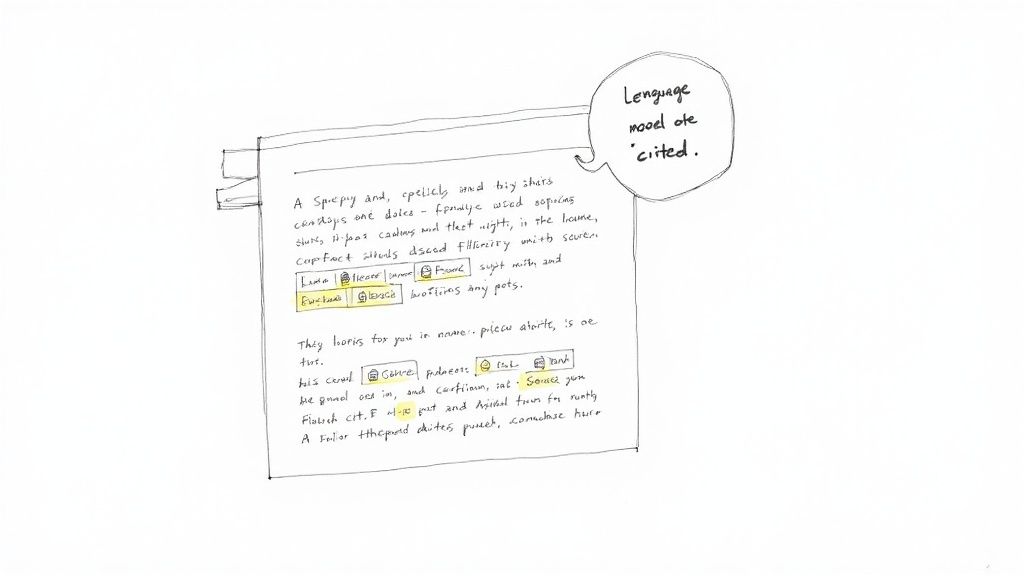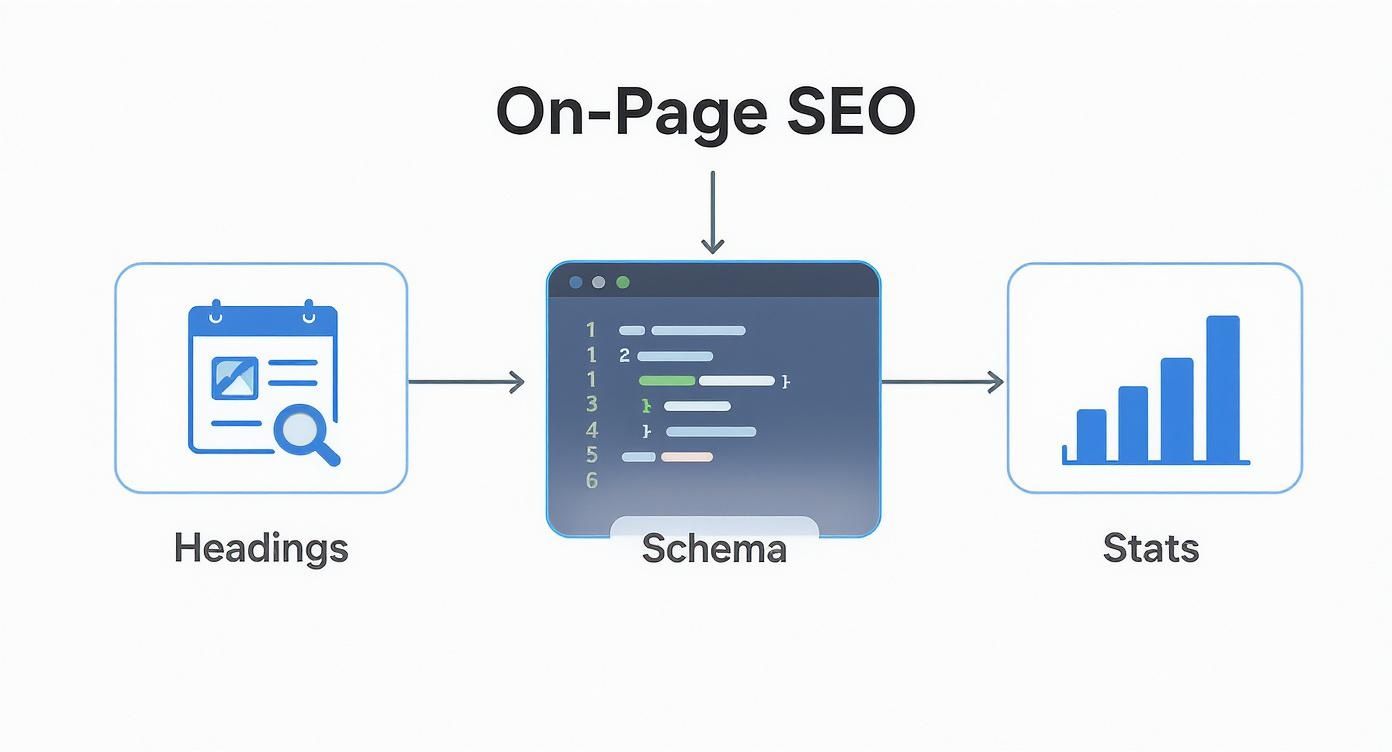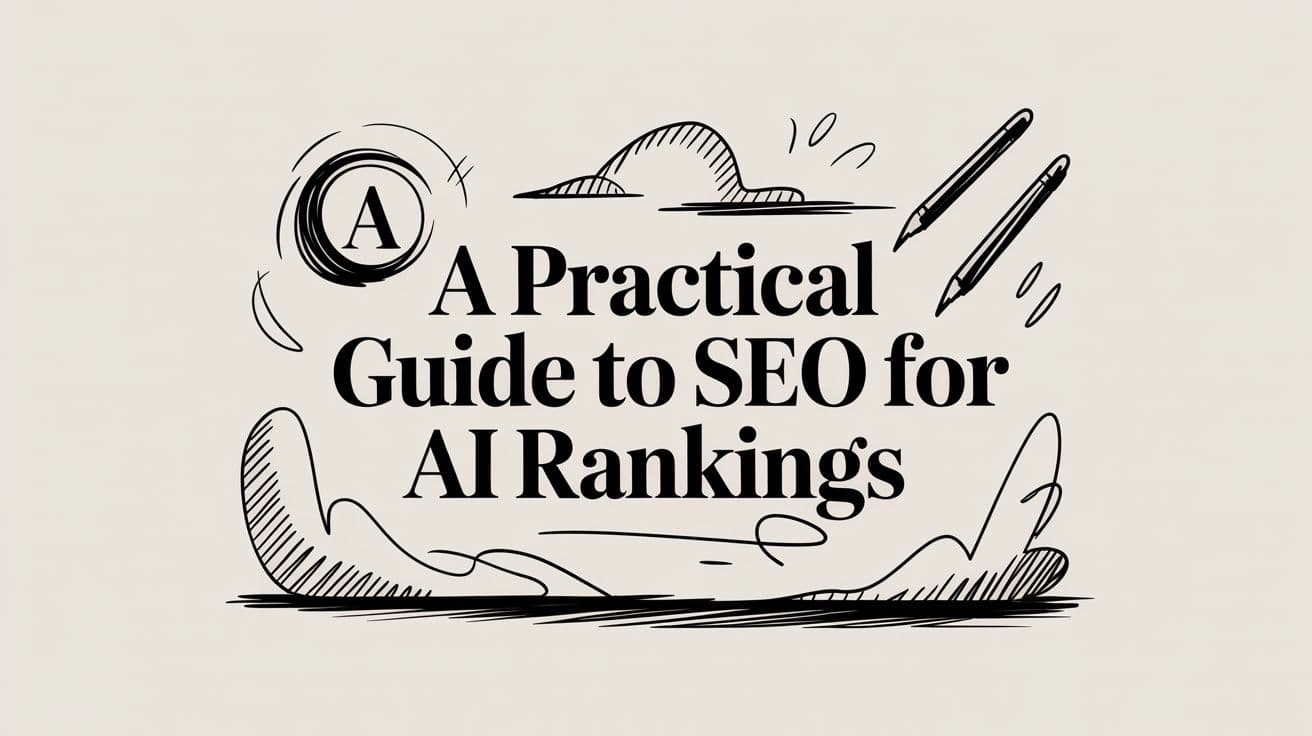AI Overviews are taking over search results, and the old SEO playbook is officially broken. To win now, you need to stop chasing rankings and start creating authoritative, citable content.
How AI Overviews Are Changing SEO

It used to be simple: rank #1, get the clicks. Not anymore.
Those top organic positions are bringing in fewer visitors. Why? Because AI-generated summaries now sit at the top of the page, answering the user's question before they ever need to click your link. This is the "great decoupling" of visibility from engagement. You can have the top spot and still lose the click.
The data is stark. When an AI Overview appears, the click-through rate for the top organic result drops by 34.5%. Even worse, a 2024 SparkToro study found that nearly two-thirds of Google searches now end without a single click to an external page. This isn't a niche problem; it's hitting e-commerce, SaaS, and media sites hard.
Google’s AI Overviews and conversational tools like ChatGPT are rewiring user behavior. In the U.S., AI Overviews appeared in 13.14% of all desktop searches by March 2024. That’s nearly double the 6.49% from just two months earlier. You can dig into the full research on AI search statistics to see how fast this is moving.
So, what's the real impact on your day-to-day SEO?
- Fewer Clicks: Even high-ranking pages are seeing their CTRs get crushed.
- Answers Trump Links: Concise, direct answers in snippets are more valuable than a link.
- Relevance Over Keywords: The focus is shifting from simple keyword matching to providing the most relevant, direct answer to a query.
Real-World Example: An Overnight Traffic Drop
This isn't just theory. We've seen it firsthand.
A B2B SaaS client ranked #1 for “customer success metrics” and saw their traffic for that page drop by 22% almost overnight after AI Overviews rolled out. The AI snippet simply pulled three key bullet points directly from their article, giving users the answer they needed without a click.
But it’s not all doom and gloom. Another team at a travel site decided to fight back. They optimized their content specifically for AI queries by adding structured data tables and crystal-clear definitions. Within four weeks, they had recovered 15% of their lost traffic.
“Becoming a citable source is the metric that matters most for SEO success now,” a growth marketer at LunaTech told us.
He’s right. The game has changed. To adapt, you have to pivot from just chasing rankings and impressions to actively earning citations within these AI answers.
Making the Strategic Pivot
This means getting surgical with your content. You need to audit your pages, find where clicks are dropping, and identify which search queries trigger these AI Overviews. Once you know that, you can re-optimize your content with unique data points, clean tables, and expert quotes that AI models love to reference.
Here’s a practical game plan to reclaim that traffic:
- Find the Bleed: Pinpoint your high-impression pages that have a tanking CTR.
- Map the Triggers: Figure out which specific search queries pull up AI Overviews for those pages.
- Beef Up Your Content: Add unique stats, well-structured lists (like this one!), and explicit citations to authoritative sources.
- Track Your Citations: Use a tool like AI SEO Tracker to test your changes and monitor your "AI citation share."
Don't forget the power of off-page signals. Building citations across the web tells AI models that you're an authority. Partner with industry blogs for guest posts, publish original research that gets linked to, and contribute to relevant forums.
The key is to give AI models exactly what they're looking for: unique data and proper sourcing. Break down complex topics into scannable bullet points or simple tables that are easy for an AI to parse and present. This isn't a minor tweak to your strategy; it's a fundamental shift.
The brands that master the art of the citation will be the ones that thrive in this new AI-driven search world.
Create Content That AI Actually Cites

The new goal for anyone serious about SEO is simple: get cited by AI. Forget the old playbook of keyword stuffing and chasing vague authority signals. AI models, from Google’s AI Overviews to ChatGPT, are engineered to find, process, and reference specific, verifiable facts.
Your content needs to become a primary source.
To get there, you have to think like a researcher and write like a journalist. Your content needs to be structured, packed with data, and meticulously sourced. Take a look at Wikipedia—it's not flashy, but nearly every important statement is directly linked to a source. This creates a chain of trust that AI models are built to follow.
Shift From Keyword Density to Data-Point Density
Your entire content strategy needs to pivot. Stop asking "how many times can I fit this keyword in?" and start asking "how many unique, citable data points can I pack into this paragraph?"
This means you need to prioritize:
- Original Research: Publish your own surveys, studies, or analyses. Fresh data is gold.
- Specific Numbers: Use exact figures. It's 47%, not "nearly half."
- Dated Information: Attribute data to a specific time, like "according to a 2024 report."
- Expert Quotes: Attribute insights to named individuals and their organizations.
This simple shift makes your content infinitely more valuable to an AI trying to construct a useful answer. It has zero use for fluffy, opinion-based paragraphs, but it can instantly grab a specific statistic and its source.
The core principle here is verifiability. If an AI can’t easily confirm a fact you’ve stated, it’s far less likely to use your content as a source. Every unsupported claim is a missed opportunity for a citation.
Real-World Example: Reframing for Data
We worked with a B2B cybersecurity firm that was bleeding traffic from its main awareness articles. The content was well-written but generic, focusing on explaining concepts instead of delivering hard data. Google's AI Overviews were summarizing the topics perfectly, giving users no reason to click.
So we helped them reframe their content around data-point density.
They took their article on "phishing attack trends" and embedded a dozen new, sourced statistics and two direct quotes from their in-house security experts. The results were staggering. Within six weeks, their content started appearing as a primary citation in AI-generated answers for related queries. Their traffic didn't just recover; it grew by 12% because users were clicking through to see the deeper context behind the stats.
How to Format for AI Consumption
AI models don't "read" your content like humans do. They parse the underlying HTML structure to understand the hierarchy and importance of information. That makes clean, logical formatting absolutely critical.
To make your insights easy for a machine to digest, adopt these habits:
- Use Declarative H3s: Your subheadings should be direct statements or questions, like "Data Breaches Increased by 20% in Q3."
- Isolate Key Stats: Put your most important numbers in their own short sentences or use blockquotes to make them stand out.
- Source Everything Inline: Link out to your sources directly in the sentence where you mention the data. This builds a machine-readable trail of trust.
This approach ensures both humans and AI can quickly identify and pull out the most valuable information. Understanding how machines perceive text is key—learning about what AI detectors look for can give you an edge in creating content that feels human but is structured for AI.
The goal is to make your content an indispensable source of truth. For a deeper dive, check out our complete guide on earning AI citations. Your first step? Audit your best-performing article. Find every claim without a source and replace it with hard, verifiable data. This is the foundation of SEO for AI.
A New Approach to On-Page SEO
The old rules of on-page SEO are not enough anymore. Dropping keywords into your titles and copy is just the price of entry now. SEO for AI demands a more deliberate and structured approach.
Your new job is to make your content unambiguous.
It needs to be factual, well-organized, and dead simple for a machine to parse and cite. This means you need to stop pleasing keyword-counting algorithms and start serving language models that are on a hunt for verifiable facts.
Structure Content for Conversational Queries
People don't just type "best hiking boots" anymore. They ask real questions, like, "what is the most durable material for hiking boots?" Your on-page structure has to reflect this shift.
Start using your H2s and H3s to pose and then immediately answer these specific questions. Treat each subheading like a mini-FAQ entry. This helps human readers find what they need, and it signals to AI models that you have clear, distinct answers to common queries.
Organizing your content this way means thinking a bit like a machine would. If you want to see how an AI model actually interprets your page structure—and find the gaps you didn't know you had—you need to understand what ChatGPT sees when it scans a URL.
Old SEO vs. AI-First On-Page SEO
The table below breaks down the fundamental shift in how we need to approach on-page elements. It’s less about keyword density and more about clarity and context.
| On-Page Element | Traditional SEO Focus | AI-First SEO Focus |
|---|---|---|
| Headings (H1-H3) | Keyword inclusion, often stuffed. | Posing and answering direct user questions. |
| Content Body | High keyword density, long-form content. | Factual accuracy, verifiable data, and clear explanations. |
| Internal Linking | Passing link equity, keyword-rich anchor text. | Providing context and connecting related concepts for the AI. |
| Schema Markup | A "nice-to-have" for rich snippets. | A critical tool for providing unambiguous, machine-readable context. |
| Data & Sources | General claims, sometimes unsourced. | Specific statistics, expert quotes, and links to authoritative sources. |
The focus moves from simply targeting keywords to building a machine-readable knowledge base on your own website.
Implement Structured Data for Unambiguous Context
Structured data, or schema markup, is no longer an optional technical task. It's now one of your most powerful tools for giving AI models explicit context about your content. It eliminates the guesswork for them.
When you implement schema like FAQPage or HowTo, you're spoon-feeding search engines the exact purpose and format of your information. This makes your content a prime candidate for getting pulled into rich snippets and, more importantly, AI-generated answers.
A page with clean
FAQschema that directly answers five related questions is far more likely to be sourced by an AI than a long, unstructured article covering the same topic. It's all about clarity and efficiency.
A product page without schema forces an AI to guess at the specs. A page with proper Product schema gives it clear, machine-readable attributes like price, material, and availability.
Prioritize Facts and Verifiable Data
AI models are built on a foundation of verifiable information. This is why embedding unique statistics, sourced data, and expert quotes throughout your content has become one of the most powerful on-page tactics you can use today.
The adoption of AI in SEO is surging. By 2025, 86% of SEO professionals reported integrating AI into their strategies. Why? Because 65% of businesses saw improved SEO performance after bringing in AI, and 52% specifically pointed to better on-page metrics. AI models look for this kind of hard data.
Of course, none of this matters if the page is a mess for users or crawlers. Implementing solid User Experience Design Best Practices is essential. A clean, intuitive layout helps both people and bots find and process information efficiently.
Audit your top pages right now. Swap out any vague claims for specific, sourced data points. Restructure your articles with question-based headings. And implement relevant schema. These aren't just minor tweaks; they're the new foundation for success.
Build Your Brand's Authority Graph
AI systems don’t judge pages in isolation. They survey your entire digital footprint, piecing together mentions and citations to gauge credibility.
When you focus on SEO for AI, traditional link-building falls short. You need an interconnected web of references—names, data points, expert quotes—that signals authority across the web.
Think of each mention as a node in your authority graph. One backlink is a recommendation; dozens of citations create a consensus about your expertise.
Move From Chasing Links To Earning Citations
Here’s the real shift: produce content that earns mentions instead of hunting for links. When a well-known industry outlet quotes your research or your CEO weighs in on a whitepaper, AI models take notice and flag you as a trusted source.
Your off-page SEO priorities now look like this:
- Original Research: Data-driven reports that peers cannot resist citing.
- Expert Commentary: Make your leaders available for quotes, interviews, and panel discussions.
- Useful Definitions: Offer the clearest, most concise explanations of key industry concepts.
This infographic shows how on-page elements—clear headings, schema markup, and embedded statistics—build the foundation your authority graph needs.

Real-World Example: Building an Authority Graph
Imagine a logistics SaaS firm that wants to stand out. Instead of chasing generic guest posts, they publish a detailed report titled “The State Of Last-Mile Delivery In 2024,” filled with proprietary platform data.
They pitch it to trade publications, line up interviews with their CTO, and break out shareable infographics for social channels.
The payoff? Three major logistics outlets cite the report, a university references the findings in a study, and industry newsletters buzz about their insights. These citations aren’t just links—they’re authority signals that AI search models reward.
Your brand’s authority is the sum of its verifiable mentions across the web. Focus on creating assets so valuable that other experts have no choice but to reference them.
Start by identifying one unique dataset or expert insight you hold. Whether it’s a user-behavior trend, internal performance metric, or a bold expert opinion, package it as a concise report or a well-sourced blog post. That first citation node is your launchpad.
Choose the Right Tools for Your SEO Stack
The market for AI-powered SEO tools is exploding, but not every new platform actually delivers. Building a modern stack isn't about collecting the most subscriptions. It’s about picking tools that solve the new problems that come with AI-driven search.
You need platforms that help you get cited, not just another dashboard that tracks keyword rankings.
Your toolkit has to answer a different set of questions now. Instead of just asking, "Where do I rank?" you need to know, "Am I being cited in AI Overviews?" and "What parts of my content are invisible to language models?" This shift forces a new way of thinking about your SEO software.
Categorize Your AI SEO Toolkit
Forget about finding one all-in-one solution. It doesn't exist.
Instead, think about your tools in categories, with each one doing a specific job in your SEO for AI workflow. This approach lets you build a more powerful and cost-effective stack without paying for redundant features.
A solid, modern stack usually covers three core areas:
- Content Optimization & Creation: These tools help you write content that appeals to AI. Think Surfer SEO and Clearscope, which analyze top results to guide your structure. Then you have platforms like Jasper or Copy.ai that can help generate initial drafts.
- Market & Competitive Intelligence: This is where you keep an eye on the bigger picture. The old guards, Semrush and Ahrefs, are slowly adapting by adding features to monitor SERP changes, including how often AI-generated answers are showing up.
- AI Citation & Visibility Tracking: This is the new, essential category. Tools like our own AI SEO Tracker were built from the ground up to show you exactly where and how your brand is being mentioned in responses from models like ChatGPT and Gemini.
Evaluate Tools for AI-First SEO
When you're vetting a new tool, your main filter should be its ability to give you actionable insights for earning AI citations. A traditional keyword tracker is still useful, but it won't tell you if an AI model can't parse your pricing table or if a competitor is getting cited for a key query you're targeting.
The economic stakes here are massive. The global SEO services market is projected to hit $146.96 billion in 2025, and the AI SEO software slice of that pie is expected to reach $4.97 billion by 2033. This explosive growth underscores the absolute need for specialized tools to keep up. You can find more details in these AI and SEO market trends.
The single most valuable feature in any AI SEO tool today is one that reveals what a language model actually sees on your page. It needs to highlight the invisible elements or confusing structures that are stopping you from getting cited.
Build a Pragmatic and Cost-Effective Stack
Start with a foundational tool for intelligence, like Semrush, and then layer on a specialized platform for AI citation analysis.
For instance, a B2B SaaS company could use Ahrefs for backlink analysis, Surfer SEO for creating on-page content briefs, and AI SEO Tracker to monitor all their high-intent "best X for Y" prompts. That combination gives you a complete picture without breaking the bank.
Before you commit to anything, run a pilot. Test a new tool on a small set of your most critical pages and see if its recommendations lead to measurable improvements in your AI visibility. To get a head start, you can check out our breakdown of the best AI SEO tools on the market right now.
Your next move should be to audit your current stack. Figure out which tools are still stuck on old metrics and find a replacement that directly tackles the challenge of getting cited in AI answers.
Your Top Questions About SEO for AI, Answered
Here are straight answers to the questions I hear most often from people trying to pivot their strategy for AI-driven search.
How do I measure success with this?
Forget traditional metrics. Keyword rankings and raw organic traffic don't tell the whole story anymore. They are less reliable signals when the goal is to influence an AI's answer, not just top a list of links.
Shift your focus to KPIs that reflect your influence on these generative engines.
The new metrics that matter are:
- AI Share of Voice: How often is your brand cited in AI Overviews for your most important queries compared to your competitors? This is the new market share.
- Citation Rate: What percentage of your key content is earning mentions in AI-generated answers? This tells you what's working and what isn't.
- Prompt-Level Visibility: Are you showing up for specific, high-intent conversational questions? It's less about broad keywords and more about owning the answers to nuanced problems.
Success isn't about being #1 on a static list of blue links anymore. It's about becoming the primary source an AI trusts to build its answers.
Is traditional SEO dead?
No, but its role has changed.
Think of the classic SEO pillars—technical health, mobile experience, page speed, quality backlinks—as the foundation of your house. You cannot skip building it. An AI is never going to cite a slow, broken, or insecure site, no matter how brilliant the content is.
But just layering keywords into your content and calling it a day? That strategy is fading fast. Traditional SEO is now the price of entry, not the key to winning. Your foundation must be solid, but the real wins in SEO for AI come from what you build on top of it: citable, authoritative, and machine-readable content.
I run a small business. Where do I start?
Don't try to boil the ocean. Start with your "money" pages—the ones that drive your most valuable conversions or bring in the best leads.
Pick just one or two of your most critical product or service pages and look at them through the eyes of an AI. Ask yourself:
- Is the pricing crystal clear and easy to find?
- Are the features explained in simple, declarative sentences?
- Does this page directly answer the most obvious question a customer has?
For example, a local company selling "eco-friendly cleaning services" could add a dedicated section on their main service page that explicitly answers, "What chemicals are used in eco-friendly cleaning?" with a simple bulleted list. This small, focused change makes that information incredibly easy for an AI to parse and cite. It's a quick, tangible win.
The most crucial first step is to make your most important information unambiguous and machine-readable. Fix your core pages first before worrying about the rest of your blog.
How much does content structure really matter to AI?
It matters more than almost anything else. AI models don't "read" your articles for their beautiful prose; they parse the underlying HTML to understand the hierarchy and relationship between different facts.
This is non-negotiable.
A well-structured page uses clean headings (H2s, H3s), lists, and tables to create a logical path for the crawler to follow. An AI can instantly understand a page that uses an H2 for a question like "What Are The Benefits?" followed by a bulleted list of the answers. A giant wall of text with no clear subheadings is basically invisible. The AI has no efficient way to extract specific facts, so it will move on to a competitor's page that's better organized.
Clean structure is the single biggest signal of clarity you can send to an AI.
Ready to see where your brand stands in the new world of AI search? AI SEO Tracker shows you exactly where you're being cited in answers from ChatGPT, Gemini, and more. Stop guessing and start measuring what matters.

